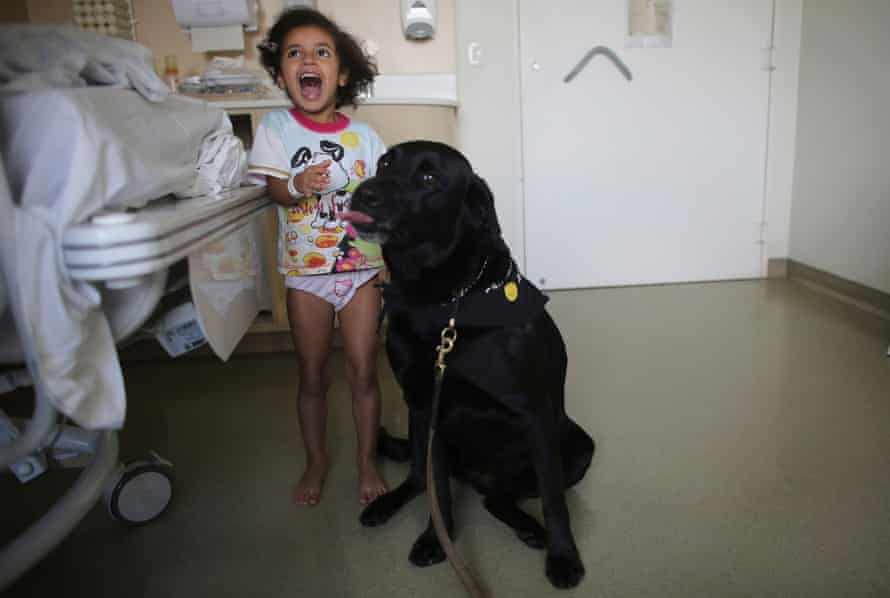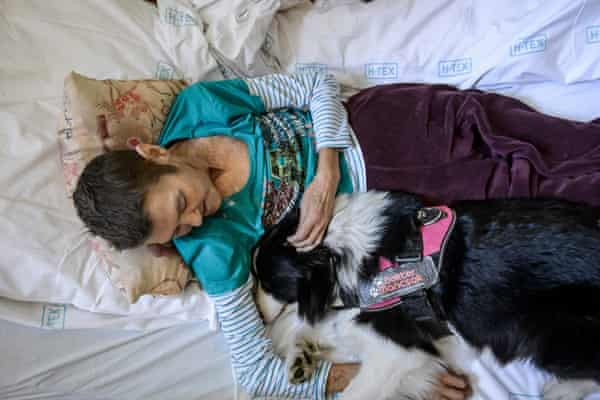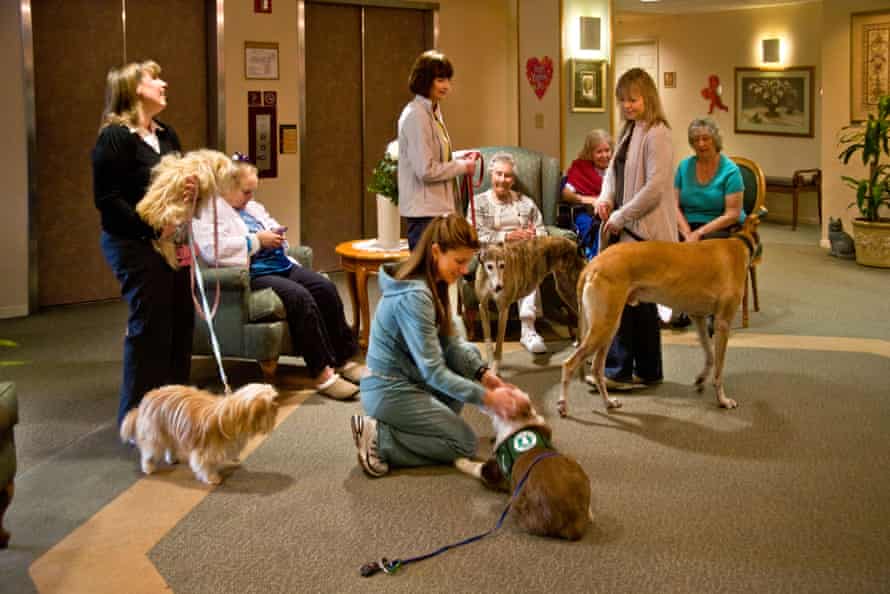How to Get the Dog to Chill Out When the Baby Is Crying
W hat is it almost animals? Every bit the bad news about the coronavirus continues, "ship me dogs and cats" has become a regular cry on social media, an easy-to-grasp shorthand for "I feel terrible, cheer me up". The response is e'er the same: a torrent of pictures of animals doing daft things – but somehow information technology has a magical, calming issue.
The therapeutic value of our relationship with our pets, particularly dogs, is increasingly recognised by researchers. Cats can be wonderful too – merely dogs take been domesticated by humans for much longer, and, equally even the most devoted cat lover volition admit, dogs are far easier to train for companionship. Most cats, as we know, are admirable for entirely unlike reasons. Marion Janner, a mental health campaigner and all-circular fauna lover, says that dogs teach us a whole range of lessons. "Dogs love us unconditionally. They're the ultimate in equal opportunities – entirely indifferent to race, gender, star sign, CV, dress size or power to throw cool moves on the dance flooring. The simplicity and depth of this love is a continuous joy, along with the health benefits of daily walks and the social delights of chats with other domestic dog walkers. They teach kids to be responsible, altruistic and compassionate and, valuably simply sadly, how to cope when someone you love dies."
Robert Doward* felt this odd effect when his health suddenly took a downward turn. "I'd been working incredibly difficult, long hours, too many days. One day I started crying and just couldn't stop. I couldn't put sentences together properly. I'd been pushing everything then difficult for so long, and I but couldn't do information technology any more."
It took a long time to put himself back together: plus some therapy, some other chore and changes to his family life. Merely the key factor, he says only one-half-jokingly, was a small Greek rescue dog chosen Maria. "Taking her out for walks, getting out into fresh air, just putting one foot in front end of the other, that lifts your spirits. And and so there's nothing like having a dog curled up abreast yous, even when you feel absolutely miserable. She'll check my face anxiously, as if she knows something is wrong. And that makes me grinning – and that somehow makes you feel amend. There is just something magic nigh dogs. Honestly, she got me through."

Photograph: Nacho Doce/Reuters
But why? What is responsible for these therapeutic furnishings? One primal aspect appears to be social recognition – the process of identifying another being as someone of import and significant to y'all. The bond that forms between owner and pet is, it seems, similar to the bond that a female parent forms with her baby.
The importance of social recognition is increasingly acknowledged for the role it plays in helping us class networks. We now understand that healthy social bonds can play a cardinal function in mental health; without them, we become lonely, depressed and physically unwell. And pets, it seems, can fulfil that part. Academic and psychologist June McNicholas points out that pets can exist a lifeline for socially isolated people.
"Pet intendance and self-intendance are linked. When y'all take a dog out for a walk, people talk to yous and that may exist the only social contact an isolated person has the whole day. If yous have a cat, yous can accept a conversation standing in the true cat food aisle in the supermarket, deciding which brand to buy. When pet owners exit the house to purchase pet food, they're more likely to buy food for themselves and when they feed their pet, they'll sit downwards to eat too. People with disabilities often discover that able-bodied people are socially awkward with them; if they have a canis familiaris it breaks downward barriers and allows a more comfortable and natural interaction."

Social recognition is something humans share with a few (though not all) mammals, including sheep and prairie voles. We are primed to wait after those we take made social bonds with; we don't breastfeed only whatsoever old baby and we don't have random dogs home from the park. Author and researcher Million Daley Olmert explains "When nosotros call our domestic dog, 'our babe' information technology is because we recognise it on a neural level equally such. And this recognition triggers the same maternal bonding brain networks that allow a mother to wait at her red, slimy newborn and say, 'mine!'"
A minor report of functional MRI brain scans in eighteen women showed like responses in regions involved in reward, emotion and affiliation when the women looked at images of their kid and pet dog.At that place were important differences though; dogs acquired activity in the fusiform gyrus (involved in facial recognition) and babies in the tegmentum (centres of reward and amalgamation). We beloved our pets, but in a fire we're primed to save the baby.

Although scientists take some understanding of social recognition and where it takes place in the brain, we nevertheless don't entirely sympathise how information technology happens. The missing link could be oxytocin, the so-called "hug", "love" or "caress" hormone. Oxytocin has a key part in both childbirth, lactation and sperm movement, but information technology also has an increasingly recognised role in our social behaviour, acting as a chemical messenger in pathways that control sexual arousal, recognition, trust, mother-infant and human being-pet bonding.
Oxytocin works in tandem with another brain hormone, vasopressin, to help to attune our response to stress and deal with social situations. Unsurprisingly, at that place's a lot of interest in a possible role for oxytocin in habit, brain injury, anorexia, depression, autism and astringent anxiety.
And there are other reasons that pets and therapy animals are increasingly recognised as being adept for our mental health. In addition to helping to alleviate stress, feet, low and loneliness, there are all the benefits that come up from having to exercise a dog. Daily walks outdoors heave concrete and emotional wellbeing. Chucking sticks, picking upwardly balls – fifty-fifty scooping upward canis familiaris poo – tin can provide an all-circular workout.
Increasingly that knowledge is existence turned to practical use, with some lovely effects. When the Centre for Mental Health ran an evaluation on therapy dogs in prisons, for example, the feedback was off the calibration. "I don't know what it is, but fifty-fifty when I am running around with [the canis familiaris] I just experience better within, calmer, more peaceful," said one prisoner. Another told the interviewer: "Dogs have a magic result on yous, you can experience their dear and that merely makes yous feel better inside you."
The good feelings persist even afterward the dogs have left, the reviewers plant, with one subject saying: "I merely walk around for the rest of the twenty-four hour period on cloud ix."

Photograph: Marmaduke St John/Alamy
Some of the UK's most unsafe and violent mental health patients are cared for in i of four high-security psychiatric hospitals. Most are diagnosed with schizophrenia and stay an average of seven years. The Land hospital in Due south Lanarkshire, Scotland, is one of these facilities and runs an beast therapy eye which gives patients the take chances to pet and care for a range of animals including chipmunks, rabbits, hens, geese, pygmy goats and pigs.
Staff say that brute therapy helps to develop trouble-solving skills, empathy, attention to the needs of others, a sense of responsibility and a way of channelling aggressive thoughts among individuals who take proved hard to reach with conventional psychiatric drugs and talking therapies.
But what if y'all don't take a pet? Is there whatsoever shortcut to reproducing the beneficial furnishings? One candidate is sildenafil (Viagra). Having sex causes an oxytocin surge in the encephalon and taking Viagra may reproduce that surge without the faff of mating. A more practical idea might be an oxytocin spray or tablet.
Simply biologist Sue Carter says that translating naturally occurring oxytocin into a commercially bachelor production is challenging. Oxytocin has unique chemical backdrop and tin shift form, making it hard to work with and measure. Chiefly, "the effects of oxytocin are context dependent, sexually dimorphic (unlike in men and women), and altered past experience."
Honestly? Gazing into your dog's eyes may produce a more than reliable sense of wellbeing than any commercially bachelor constructed product.
* Some names and details accept been changed.
Source: https://www.theguardian.com/society/2020/mar/17/dogs-have-a-magic-effect-the-power-of-pets-on-our-mental-health
0 Response to "How to Get the Dog to Chill Out When the Baby Is Crying"
Postar um comentário